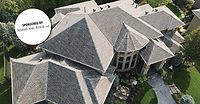Sponsored by Elevate
On Mission with Metal

The upward trend in metal roofing and its familiarity among roofing contractors shows no signs of abating. Material usage in both commercial and residential sectors showed that metal roofing trailed only single-ply in response to RC’s 2023 State of the Industry annual survey.
While used in commercial installations for decades, metal roofing's popularity continues to grow within the residential sphere over the last few years. Companies are also taking notice, diversifying their product lines, enhancing contractor training and making a forceful case on behalf of metal’s resiliency.
Karan Patel is the metal product manager with Elevate, the commercial roofing brand of the Holcim Building Envelope division, and oversees metal "strategy," metal product categories, and works with all aspects of the company’s metal operations, including sales. He recently discussed metal’s ascent during a video chat with Roofing Contractor.
RC: How would you describe the current state of the metal roofing market?
KP: It's definitely progressing upward. There's a lot more attention on metal roofing. And, you know, encapsulating the overall edge as well, because it's extremely important that you have a solid metal edge profile to ensure the overall health of your building envelope.
RC: How does your company fit into that discussion?
KP: As an industry leader in commercial roofing, we’re proud to carry an array of dependable and high-performing metal roofing systems. We have three main categories for our metal profile. So we have the roofing products, edge products, and the wall components as well. So all those coming together provide a full system that ensures longevity through the product life cycle or the building lifecycle.
RC: And how long-term are we talking?
KP: In terms of longevity, we’re looking at upwards of 30 years for metal components.
Not only is that aesthetic quality and finish quality, but also overall durability for that system. So if there were some sort of wind event that would occur in a particular location, you can be assured with your metal roofing assembly that it's going to withstand the test of time.
RC: What is the direction of metal demand in roofing?
KP: I think we're finding a lot more contractors using metal as a way to differentiate themselves,
They're certainly looking at metal as a category where they can highlight their skill. So because it's one of the only assemblies that you can see from the ground, it does provide a way for you to leave your mark on that particular roofing assembly, and therefore it creates a draw to that particular contractor. And those that do it really well are going to get more projects and win more jobs. So it's very exciting to see that trend going more and more towards metal roofing assembly.
RC: What’s the challenge in getting contractors that want to work with metal to work with Elevate?
KP: What's been nice about the Holcim acquisition overall for Elevate is the ability to expand rapidly. So this year alone we're expanding into three different spaces–Texas, Florida, and Utah.
Being closer to the consumer and being the preferred supplier locally is part one, and making sure that we can get the supplies needed for someone to bend and shape the different metal profiles as needed. Then the second phase would be ensuring that they're tied in with our sales team as well as our technical teams to ensure all the details, all the tie-ins and construction aspects are installed appropriately so that they withstand the test of time.
RC: How are you contributing to the resiliency movement in roofing?
KP: We view ourselves as a leader in the global environment and are pushing forward with the recyclability of metal. It's 100% recyclable at the end of its product life cycle, and it has the longest lasting roofing assembly overall. Both play really strong roles in being able to repeat, reuse, and recycle the components overall from the exterior facade to all the different components of what I call the roofing sandwich.
RC: Do you believe extreme weather events like those we’ve recently seen across the country will help define metal roofing’s future?
KP: Absolutely. With the frequency and intensity of recent extreme weather events, this trend has brought the importance of resilient infrastructure into sharp focus, and metal roofs are emerging as a front-runner in this context. They're not just known for their exceptional resilience and durability against severe weather challenges, but metal roofs also have an undeniable aesthetic edge and ability to enhance curb appeal. When we talk about the future of roofing, we're considering both performance and appearance. Why settle for just one when metal roofing offers both? As we face high-wind and extreme weather events, I envision a future where metal roofing's blend of durability, energy efficiency, and aesthetics makes it an even more popular choice among builders and homeowners alike.

Metal roofing has a reputation for being more expensive or pricey than other systems, but advocates say its longevity makes it the highest return on investment.
RC: Are there still big misconceptions about metal roofing?
KP: There can be a higher price associated with the metal category, and so what we really want to do is break down that myth that metal roofing is more expensive when, in fact, you're comparing system to system over time, metal actually has the highest return for your investment.
RC: What has you optimistic about metal roofing’s future?
KP: I think, the technology space is definitely attractive. It's become natural to host training sessions virtually and be able to connect with audiences really quickly. So we can host these sessions multiple times in a week, decrease that knowledge gap, and make all contractors much more knowledgeable about the overall systems that they're utilizing. The ability to connect, train, and develop our users and partners is becoming second nature.
Looking for a reprint of this article?
From high-res PDFs to custom plaques, order your copy today!







